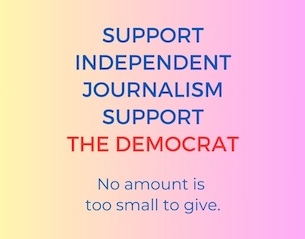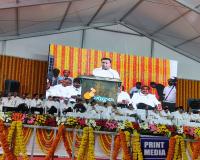- More
- Understand the Difference between Journalism and Media : P Sainath
Understand the Difference between Journalism and Media : P Sainath
Trina Chowdhury : Kolkata : One of world’s best known experts on famine P. Sainath delved on some extremely important journalistic issues on the first day of #MediaNext 2020 that focused on Digital Journalism. #MediaNext 2020 is being organized by the Kolkata-based Adamas University in association with Sharda University, Birla Global University, DME, AIMEC, Lok Samvad Sansthan,

Trina Chowdhury : Kolkata : One of world’s best known experts on famine P. Sainath delved on some extremely important journalistic issues on the first day of #MediaNext 2020 that focused on Digital Journalism.
#MediaNext 2020 is being organized by the Kolkata-based Adamas University in association with Sharda University, Birla Global University, DME, AIMEC, Lok Samvad Sansthan, exchange4media, ABP Education and IndiaReal.in. The mega conclave is being organized over a period of 10 days from June 1, 2020 to June 10, 2020. Each day of the conclave focuses on one specialized domain of the Media and Entertainment (M&E) industry and the impact of the Covid-19 pandemic on that specific domain.
Sainath, who was the Rural Affairs Editor of The Hindu, is the founder editor of People’s Archive of Rural India (PARI), an acclaimed digital platform that primarily focuses on rural journalism. A recipient of the Ramnath Goenka ‘Journalist of the Year’ award, Sainath was hailed by Amartya Sen as “one of the world’s greatest experts on famine and hunger”. The University of Alberta honoured Sainath with the Honorary Doctor of Letters degree (D.Litt.). He was also the McGraw Professor of Writing at the University of Princeton. His best-selling book ‘Everybody Loves a Good Drought’, published in 1996 by Penguin Books is considered one of the finest texts on rural poverty and farmers’ distress.
Migrant Labourers and Indian Media
Let me begin for those who are aspiring media persons, journalists, researchers with a small exercise. Do a research for the past 10 years in online or physical Indian mainstream media. It can be audio, video or print or digital media. Is there a single programme about migrant labourers? Find me a series or a particular coverage, panel discussion or anything of any newspaper, websites or news channel, which entirely focused on them. I am not talking about any opinion writing or a passing reporting. I assure you; you will not get. You might find it in The Hindu between 2011 and 14, but mostly you can’t. According to census 2011, 28 percent of the total population are migrants. All of them didn’t not cross border as there are many kinds of migration occurring in India.
Migrant Labourers and Indian Media in this Covis-19 Situation
As Indian national or so called mainstream media had no connection with this migrant labour, workers, and the poorest Indian citizens, that’s why in this pandemic situation they just have no clue about them. How many they are, where they came from, where they want to go are totally unknown to them. Neither the census nor the national survey of India shows interest about them. We never gave a bit of coverage about them. I am also the part of this media that I am criticizing now. I spent around 35 years in the industry.
“I don’t know how we call something mainstream media when it excludes the mainstream.”
Rural Coverage by Mainstream Media
In average, most of the Indian newspaper or national daily devotes only 0.67 percent of their front page to cover the rural sectors of India in the five years. Centre for Media Studies, New Delhi, the oldest media monitoring organisation of the country said that this is 0.67 percent also because there are election campaigns in these five years. When there is an, election the percentage might change to 5 percent to 8 percent. But in average, it is just 0.18 to 0.24 percent of the coverage of national media, which they do with rural affairs.
In 2022, the Indian press will cross of its glorious 200 years. Raja Ram Mohan Roy was one of the founders of this journalism sector where he and many great persons of that time focused on the have-nots. But in the last 25 to 30 years, Indian media is continuously disconnecting themselves from the common public – those who are poor or marginalize as they have no purchasing power and they can’t buy the product of the advertisements which is the main concern of media.
In 2006, young reporters of The Times of India in Mumbai approached their leaders that they should cover the farmer’s suicide and many more rural issues but the authority said that the dying farmers do not buy ‘The Times of India’ but an elite of south Bombay does. In 30 years, media reduced journalism to a revenue stream.
I will cover you if I make money to cover you is the principle they have now. In 1988, when I joined as a journalist, there was a labour employment correspondent. Today, is there anyone on this bit he or she will be named as industrial relation correspondent. They say about industry not for the workers of the industry. When it is called the agriculture affair, it is not that they covering about the farmers, they cover agriculture ministry and business as well. The reporters sung the saga of the ruling agriculture minister, which was prominently seen in the case of Sharad Power. Now you don’t even know the name of the agriculture minister you can only know about Prime Minister and Home Minister. Thus, we landed in a mess with no clue. When we needed more journalists on the field from March 25, Hindustan Times laid off 1,000 and more reporters and TOI is giving half of salary. Thus, journalism is getting ruined.
People’s Archive of Rural India has been covering these issues from 2014.
Future of Migrants
When a migrant worker is returning home these days, at first, they have to deal with police as they should go to the quarantine. The government took very few initiatives for their quarantine camp. They have to stay in field or in an open place in this high temperature of summer where they are dying in non Covid-19 decease.
To find work they left their home but now returned home again. Now they will be in agriculture where there is already high tuff pressure. Statistics said that around 122 million people lost their jobs. Food crops and vegetables remain unsold. Even the handloom handicraft industry, who is the second biggest employer has been suffering. You named a profession and I will tell they are in severe trouble.
The Government of India failed and failed miserably to handle this Covis-19 situation. In this total period of lockdown, the Prime Minister addressed the nation five times and only in his last speech did he finally name the migrant labours.
Not all the journalists of the media industry are forgetting journalism. There are many good people in this sector, which I am criticizing. In Mumbai and Chennai, many reporters have tested positive for Covid-19 while they were doing their work.
To get some relief, at first farmers have to secure their Kharif food crops. We have to enlarge NREGS (National Rural Employment Guarantee Act). People will come back because they have no option left. We need to build a great National Health system widely.
000











